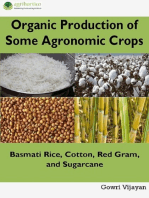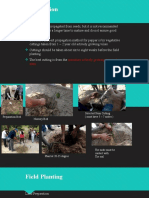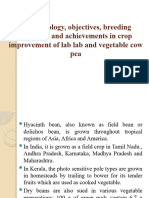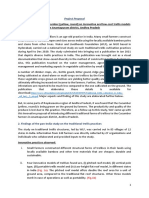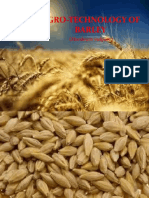Bulb
Bulb
Uploaded by
Adrian MausigCopyright:
Available Formats
Bulb
Bulb
Uploaded by
Adrian MausigOriginal Description:
Copyright
Available Formats
Share this document
Did you find this document useful?
Is this content inappropriate?
Copyright:
Available Formats
Bulb
Bulb
Uploaded by
Adrian MausigCopyright:
Available Formats
Bulb Onion Production Guide
Introduction Bulb onion (allium cepa L.), locally known as sibuyas, is probably the most indispensable culinary ingredient in the world. It is a favorite seasoning, and its pungent aroma and sharp taste makes it ideal for spicing up meat, salads and vegetable dishes. It is also used to cure a wide array of physiological disorders such as cough, obesity, insomnia, hemorrhoid and constipation. There are two types of bulb onion grown in the Philippines; the yellow and the red onion. The yellow varieties grown for the traditional market are either the granex (flat) or the grano (round) type, short day onions. The red varieties, on the other hand, are produced because of their long storage life. Strains of Red Creole and Red Pinoy are among the popular varieties being grown. Production and Trade Bulb onions are grown in about 11,998 ha (1997) mainly in Central Luzon and the Ilocos Region. They are grown both for the local and export markets. In 1997, 7,296 t of fresh onions valued at P109 million were exported to Japan, Hongkong, Singapore, and Thailand. Production Management Varieties Yellow Onions Yellow Granex Superex Cal 120 Cal 202 Liberty Red Onions Hybrids Red Orient Red Creole Red Pinoy BGS 95 (F1 hybrid) Capri
Climatic and Soil Requirements Bulb Onions grow well in friable and well-drained loam soil with good water holding capacity and pH between 6 & 7. For best growth and bulb quality, onion requires cooler weather during the early stages of growth and a dry atmosphere with moderately high temperature for bulb development & maturation. Planting can be done as early as October (yellow onions) to as late as January (red onions). Seedling Production A 1-ha production area requires 5 kg seeds. A 300-500 m2 seedbed produces enough transplants for one ha/ Prepare beds 1 m wide & incorporate animal manure and rice hull.. Line sows 3-5 kg. seeds in rows set across the bed 7-10 cm apart. Distribute seeds thinly and evenly to control damping off. Cover the seeds lightly with compost and mulch with rice straw or grass clippings. Maintain adequate soil moisture. Protect the seedbed against direct sunlight and rain with nylon net or removable plastic tunnels. Reduce watering and expose seedlings to full sunlight one week before transplanting. Land Preparation One month prior to land preparation, apply about 30 cm layer of rice hull over the entire field & burn for about two weeks. Incorporate burnt rice hull during land preparation. Burnt rice hull reduces occurrence of weeds & diseases & improves soil texture. Land preparation is done one month prior to transplanting. The use of tractor-driven implement requires 1-2 plowing & harrowing operations. Apply animal manure at 10-15 t/ha prior to bed preparation. Beds 1 m wide are recommended. Transplanting Transplant seedlings 4-6 weeks after sowing. Gently uproot the seedlings to prevent root damage. Plant at a distance of 15 cm between rows & 3-5 cm between transplants can also be practiced. Use markers for proper spacing & to facilitate transplanting. After marking, use dibbles to make holes. Plant deep enough but not too deep. Care must be taken so as not to damage the basal portion of the plant. Place the white portion of the plant below the soil surface. Press the soil firmly around the basal portion. Irrigate the field before and after transplanting. Fertilization In the absence of soil analysis, a 1-ha production area requires 8.5-11.4 bags of ammonium sulfate (21-00), 6.6-26.7 bags super phosphate (0-18-0) and 2-4 bags muriate of potash (0-0-60). Apply all of 0-18-0 & half of 21-0-0 & 0-0-60 as basal fertilizer. Side-dress remaining 21-0-0 & 0-060 at 30, 45 & 60 days after transplanting. High nitrogen rates tend to shorten storage life of onions. Combine herbicide application with hand weeding to produce a good quality crop. Irrigation Bulb onions require adequate moisture for steady, continuous & desirable growth. Depending on soil types, irrigation varies between 4 & 7 days. Stop irrigation 2-3 weeks before harvest, or when 20-30% of the tops fold over. The last irrigation should be a light one.
Pest & Disease Management Purple blotch (Alternaria porri), leaf blight (Botrytis spp.), white-tip disease (Phytophthora porri), and downy mildew (Peronospora destructor). Regulate humidity within the field through proper irrigation. Eliminate debris from previous crop. Spray compost tea (compost tea is prepared by fermenting rice compost for 10-14 days. The effluent is sprayed to control foliar diseases). Remove infected leaves. Practice crop rotation.Pink root (Pyrenochaeta terrestris). Practice soil solarization. Use resistant varieties. Bacterial soft rot (Erwinia carotovora), neck rot (botrytis allii), & onion smut (Uroccystis cepulae). Harvests only mature bulbs. Maintain good air circulation during curing, packing & storage. Practice crop rotation. Sour skin (Pseudomonas cepacia) & slippery skin (P. alliicola). Use furrow irrigation. Incorporate copper sulfate at the last fertilization & fungicide application. Thrips (Thrips tabaci), army worm (Spodoptera exigua), cutworm (Argotis spp.), & leafminer (Liriomyza spp.) Use overhead irrigation & high pressure spray of water & insecticidal soap solution. Remove badly infested leaves. Spray hot pepper extract, or spread wood ash to control army worm & cutworm. To control leafminer, spray chlorox solution (1:10 commercial chlorox & water) & rinse one hour later with water. Manage weeds properly to maintain sufficient population of natural enemies. Harvesting Harvest when the tops begin to fold over. Pull mature plants/bulbs manually from the soil. Post harvest Cure harvested bulb for 10-14 days in a sunny, well-ventilated area. Align onions so that the leaves of one onion cover the bulb of another. Clip dried leaves 1.5 inches from the stem and remove all roots. Grade bulbs according to size & quality. Pack in jute or net sacks for storage and/or immediate disposal. Cost and Return Analysis Per Hectare ITEMS I. VARIABLE COSTS A. Labor (P150/MD) Plowing Harrowing (2x) Bedding Manure application Seedling production (15 MD) Transplanting (25 MD) Fertilization (3x) (12MD Mulching (5 MD) Irrigation (20 MD) Spraying ( 20 MD) Weeding (3x) (30MD) Harvesting (20 MD) Post harvest operations (35 MD) Sub-total AMOUNT (P) P 115,270 1,500 1,000 1,500 1,500 2,250 3,750 1,800 750 3,000 3,000 4,500 3,000 5,250 32,800
B. Materials Seeds (5 kg//ha) 4,250 Animal manure (10 t) 10,000 Fertilizers 14-14-14 (7 bags) 2,450 46-0-0 ( 2 bags) 930 0-0-60 (0.5 bag) 300 0-18-0 (2 bags) 1,100 Insecticides 8,000 Fuel & Oil 5,000 Miscellaneous 5,000 Sub-total
37,030
II. FIXED COSTS 18,063 Land rental 5,000 Depreciation 5 pcs. Scythe (2 yrs) 63 5 pcs. Hoe ( 3 yrs) 125 3 pcs. Shovel (3 yrs) 75 2 knapsack sprayers (5 yrs) 800 Interest on Loans at 20% int. p.a. 12,000 TOTAL COSTS 87,893 GROSS INCOME a 200,000 NET INCOME 112,107 __________________________________________ a With marketable yield of 20 t/ha at P10/kg
You might also like
- JXBS-3001-TR 485 Soil Integrated SensorDocument23 pagesJXBS-3001-TR 485 Soil Integrated SensorSheikh Nasir KamarudinNo ratings yet
- Yogurt HACCP Plan PDFDocument38 pagesYogurt HACCP Plan PDFserenela100% (5)
- Precision Farming of MarigoldDocument82 pagesPrecision Farming of MarigoldNivedhaNo ratings yet
- Business Plan Rusenyi Coffee Growers - Final - Version - FinalDocument53 pagesBusiness Plan Rusenyi Coffee Growers - Final - Version - FinalRene100% (1)
- Black Pepper Cultivation-EswarDocument69 pagesBlack Pepper Cultivation-EswarDr.Eswara Reddy Siddareddy100% (1)
- Production Guide On Bulb Onion: Seedbed Establishment and Seed Sowing (Nursery)Document3 pagesProduction Guide On Bulb Onion: Seedbed Establishment and Seed Sowing (Nursery)Kaycin Duzon SorianoNo ratings yet
- Bulb OnionDocument4 pagesBulb OnionPaula Anjelica RiveraNo ratings yet
- Ocimum, Rose, Vetiver and GeraniumDocument28 pagesOcimum, Rose, Vetiver and GeraniumGAURAV GUPTANo ratings yet
- CeleryDocument16 pagesCeleryNitika100% (1)
- Varietal Trial On Cucumbe Varieties Under Tabuk City ConditionDocument13 pagesVarietal Trial On Cucumbe Varieties Under Tabuk City ConditionMichael AngeloNo ratings yet
- Onion Farrming Manual RevDocument18 pagesOnion Farrming Manual Revsimbeyefranklin44No ratings yet
- Tomato Disease and Insect Control ManualDocument36 pagesTomato Disease and Insect Control ManualBashar DaoudNo ratings yet
- Pumpkin PDFDocument5 pagesPumpkin PDFm_k_navghare4041No ratings yet
- Curry Leaves Farming Guide Curry Leaf CultivationDocument2 pagesCurry Leaves Farming Guide Curry Leaf CultivationMoolam RaoNo ratings yet
- Cultivation Practice of LucerneDocument18 pagesCultivation Practice of LucerneSukra Shrestha100% (1)
- Production Technology of GingerDocument14 pagesProduction Technology of GingerYanamandala VaishnaviNo ratings yet
- Jackfruit Farming Information Guide - AgrifarmingDocument4 pagesJackfruit Farming Information Guide - AgrifarmingMallik ArjunNo ratings yet
- Tomato E BookDocument12 pagesTomato E BookDonald-Virginia KjellbergNo ratings yet
- PineappleDocument8 pagesPineappleAltaf ShaikhNo ratings yet
- Intercultural Operations PDFDocument1 pageIntercultural Operations PDFsam100% (1)
- French Beans Cultivation GuideDocument8 pagesFrench Beans Cultivation Guidesekarkk100% (1)
- Protected Cultivation CourseDocument23 pagesProtected Cultivation CourseMuhhib AttaullahNo ratings yet
- Banana Production GuideDocument5 pagesBanana Production GuideSharon Rose GalopeNo ratings yet
- Anthurium CultivationDocument3 pagesAnthurium CultivationDr.Eswara Reddy Siddareddy100% (1)
- Crop Production Technology - Kharif CropsDocument32 pagesCrop Production Technology - Kharif CropsAKSHAY THOTTUVANo ratings yet
- High Density PlantingDocument8 pagesHigh Density PlantingDr Parag B Jadhav100% (2)
- Chap-5 Application of FertilizersDocument18 pagesChap-5 Application of FertilizersRavindra Kumar NiranjanNo ratings yet
- L7.oil CropsDocument22 pagesL7.oil CropsMohaajanan Ali100% (1)
- Gap Turmeric 1Document28 pagesGap Turmeric 1Jayaprakash Muthuvat0% (1)
- Pepper PropagationDocument6 pagesPepper Propagationmohd fiqriNo ratings yet
- Papaya Production GuideDocument5 pagesPapaya Production GuideFrances Lawrence DenostaNo ratings yet
- PapayaDocument12 pagesPapayaAssefa FikaduNo ratings yet
- Tomato Growing GuideDocument17 pagesTomato Growing GuideEmmanuel Nyachoke100% (1)
- Cultivation and Uses of CerealsDocument24 pagesCultivation and Uses of Cerealsgaurav yadavNo ratings yet
- Calender ofDocument18 pagesCalender ofStan leeNo ratings yet
- AGRO 101 Principles of Agronomy - Acharya NG Ranga Agricultural PDFDocument133 pagesAGRO 101 Principles of Agronomy - Acharya NG Ranga Agricultural PDFShalini Singh100% (1)
- Neem Cultivation-457Document9 pagesNeem Cultivation-457mandaremNo ratings yet
- Ac681e01 - FAO (2002) - The Lychee Crop in The Asia and PacificDocument61 pagesAc681e01 - FAO (2002) - The Lychee Crop in The Asia and PacificedysutiarsoNo ratings yet
- Intercultural Operations in Cole CropsDocument2 pagesIntercultural Operations in Cole CropsDr.Eswara Reddy SiddareddyNo ratings yet
- Tillage TypesDocument33 pagesTillage TypessushreepratikshyaNo ratings yet
- Agricultural Science Work.Document15 pagesAgricultural Science Work.Isabella persad100% (1)
- Stevia RebaudianaDocument8 pagesStevia RebaudianaShabbirAli bhattNo ratings yet
- MicrograftingDocument1 pageMicrograftingDrRuby Ranjan SharmaNo ratings yet
- Pro Gui BasilDocument26 pagesPro Gui BasilJackophiliNo ratings yet
- VSC 301 - Lablab and Cowpea - PPT 1 - Agri JunctionDocument62 pagesVSC 301 - Lablab and Cowpea - PPT 1 - Agri Junctionsivakarthikkeyen321No ratings yet
- Seed Prodtn of Veg CropsDocument63 pagesSeed Prodtn of Veg CropsDR V S PATILNo ratings yet
- Project Proposal (Revised) - Pilot Project On Cucumber Cultivation On Trellises - 30 July 2021Document8 pagesProject Proposal (Revised) - Pilot Project On Cucumber Cultivation On Trellises - 30 July 2021PEDDI REDDYNo ratings yet
- Vegetable Seed Production A Ready ReckonerDocument39 pagesVegetable Seed Production A Ready ReckonerHeart ChNo ratings yet
- 3 Plant Protection II PDFDocument129 pages3 Plant Protection II PDFAvijitSinharoyNo ratings yet
- Corn RefDocument38 pagesCorn RefSteven Hans HaryonoNo ratings yet
- Growing Onions ProfitablyDocument8 pagesGrowing Onions ProfitablyNyasha VincentNo ratings yet
- Recognizing Tomato ProblemsDocument6 pagesRecognizing Tomato ProblemsJohn GiannakidisNo ratings yet
- How To Grow Carrots: Detailed CultivationDocument1 pageHow To Grow Carrots: Detailed CultivationAll Good Things Organic Seeds100% (1)
- Black Pepper Planting GuideDocument5 pagesBlack Pepper Planting GuideQiu TengkuanNo ratings yet
- Afrostainfarmtech.: Onion and Garlic Production GuideDocument3 pagesAfrostainfarmtech.: Onion and Garlic Production Guidewalter mombeNo ratings yet
- Organic and Inorganic PesticidesDocument25 pagesOrganic and Inorganic Pesticidesmomiii.2410No ratings yet
- Production Technology of LentilDocument17 pagesProduction Technology of LentilHAMZA'S VLOGSNo ratings yet
- Chickpea: Vulgaris) and Dry Peas (Pisum Sativum L.) - Chickpea Seeds Contain On Average 18-22% ProteinDocument7 pagesChickpea: Vulgaris) and Dry Peas (Pisum Sativum L.) - Chickpea Seeds Contain On Average 18-22% ProteinGanpat Lal SharmaNo ratings yet
- Agro-Technology of Barley: (Hordeum Vulgare)Document21 pagesAgro-Technology of Barley: (Hordeum Vulgare)Precious Prince100% (1)
- Fertilizer Schedule For Vegetables PDFDocument6 pagesFertilizer Schedule For Vegetables PDFPrasobh ShamohanNo ratings yet
- Wood VinegarDocument7 pagesWood VinegarAdrian MausigNo ratings yet
- Wood Vinegar For Crop and Livestock ProductionDocument8 pagesWood Vinegar For Crop and Livestock ProductionAdrian Mausig100% (1)
- Marinduque State College: Republic of The Philippines School of Agriculture Poctoy, Torrijos, MarinduqueDocument2 pagesMarinduque State College: Republic of The Philippines School of Agriculture Poctoy, Torrijos, MarinduqueAdrian MausigNo ratings yet
- Oxford Oregon DebateDocument7 pagesOxford Oregon DebateAdrian Mausig100% (3)
- Natural Enemies of Corn PestsDocument43 pagesNatural Enemies of Corn PestsAdrian Mausig100% (3)
- Def of TermsDocument48 pagesDef of TermsAdrian MausigNo ratings yet
- TomexiaDocument1 pageTomexiaAdrian MausigNo ratings yet
- Basic Microscopy - An Important Skill For Plant Pathologists: ObjectivesDocument11 pagesBasic Microscopy - An Important Skill For Plant Pathologists: ObjectivesAdrian MausigNo ratings yet
- Fruit Spanish Colonization of The Americas Greenhouses: Nix v. HeddenDocument1 pageFruit Spanish Colonization of The Americas Greenhouses: Nix v. HeddenAdrian MausigNo ratings yet
- Plastic Flooring For Goat (1 FT X 2 FT)Document1 pagePlastic Flooring For Goat (1 FT X 2 FT)Adrian MausigNo ratings yet
- Infection and EpizootiologyDocument3 pagesInfection and EpizootiologyAdrian Mausig100% (1)
- Indigenous Food Plants StudyDocument109 pagesIndigenous Food Plants StudyAdrian MausigNo ratings yet
- Economic Thresholds of Insect Pest - Printer FriendlyDocument12 pagesEconomic Thresholds of Insect Pest - Printer FriendlyAdrian MausigNo ratings yet
- INM RICE-organic FertilizersDocument1 pageINM RICE-organic FertilizersAdrian MausigNo ratings yet
- IPM TomatoDocument4 pagesIPM TomatoAdrian Mausig0% (1)
- Propagation ProtocolsDocument22 pagesPropagation ProtocolsAdrian MausigNo ratings yet
- Preservation by Use of High TemperatureDocument37 pagesPreservation by Use of High TemperatureAdrian Mausig84% (19)
- Bacterial Infections Among InsectsDocument2 pagesBacterial Infections Among InsectsAdrian MausigNo ratings yet
- INM Rice (Organic Fert.)Document22 pagesINM Rice (Organic Fert.)Adrian MausigNo ratings yet
- Social Dimensions of EducationDocument14 pagesSocial Dimensions of EducationAdrian Mausig100% (6)
- Plant Pathology Laboratory OutlineDocument7 pagesPlant Pathology Laboratory OutlineAdrian Mausig0% (1)
- Rubric S 2004Document45 pagesRubric S 2004Adrian MausigNo ratings yet
- Soil Resources Class 10 ICSEDocument21 pagesSoil Resources Class 10 ICSEshreyammandal001No ratings yet
- Chapter 4 InfiltrationDocument15 pagesChapter 4 Infiltrationnimcan100% (1)
- KS C Readers CompDocument96 pagesKS C Readers CompZULY TATIANA DIAZ LOPEZNo ratings yet
- Suprem 2013Document10 pagesSuprem 2013jorgeortizramos1936No ratings yet
- Construction Best Practice For Underground Cable Installation - 0Document9 pagesConstruction Best Practice For Underground Cable Installation - 0Rahil TasawarNo ratings yet
- Evs 502Document387 pagesEvs 502Mohit BhandariNo ratings yet
- Banana Growing Guide Cavendish Bananas PDFDocument28 pagesBanana Growing Guide Cavendish Bananas PDFvrushankhallayrock100% (3)
- Geotextile IntroductionDocument2 pagesGeotextile IntroductionHarifNo ratings yet
- Fao 2021Document84 pagesFao 2021Anonymous gDWkIhENo ratings yet
- Excavation and Excavation Support: Foundation ConstructionDocument26 pagesExcavation and Excavation Support: Foundation ConstructionSaad SANo ratings yet
- DRR Quarter 4 Week 8Document11 pagesDRR Quarter 4 Week 8Shastine Claor100% (1)
- Check Soil Bearing Capacity Pile AstakaDocument2 pagesCheck Soil Bearing Capacity Pile AstakaAzwani AbdullahNo ratings yet
- TD18 003Document4 pagesTD18 003Felipe LageNo ratings yet
- Pile FoundationDocument16 pagesPile FoundationNikita Sheth100% (1)
- Case StudyDocument3 pagesCase StudyathiraiNo ratings yet
- Organic Gardening Recipe BookDocument18 pagesOrganic Gardening Recipe Bookdpaul25No ratings yet
- Biological Molecules 3 QPDocument5 pagesBiological Molecules 3 QPSOHAIRA AFZAALNo ratings yet
- Carboveg PlantsDocument4 pagesCarboveg PlantsdebprasNo ratings yet
- Artikel - The Economics of Soil Erotion Theory Methodology and Examples PDFDocument29 pagesArtikel - The Economics of Soil Erotion Theory Methodology and Examples PDFIwan Alim SaputraNo ratings yet
- DTSpaper110915 PDFDocument9 pagesDTSpaper110915 PDFManohar LalNo ratings yet
- Excavations and Trenching: 29 CFR 1926 Subpart PDocument119 pagesExcavations and Trenching: 29 CFR 1926 Subpart PHundeejireenyaNo ratings yet
- Holtville Rocket Range No. 1Document160 pagesHoltville Rocket Range No. 1CAP History LibraryNo ratings yet
- CompactionDocument16 pagesCompactionahmed alhajNo ratings yet
- Chapter 5Document5 pagesChapter 5Johar HafeezNo ratings yet
- SAIC-Q-1041 Asphalt Pavement Prime Coat & Tack Coating InspectionDocument8 pagesSAIC-Q-1041 Asphalt Pavement Prime Coat & Tack Coating InspectionAbdul Hannan100% (1)
- The Fertiliser Trap English - Embargoed 8th November 2022Document15 pagesThe Fertiliser Trap English - Embargoed 8th November 2022joneltmpfc3r6No ratings yet
- BE-629-327 Report On Geotechnical InvestigationsDocument55 pagesBE-629-327 Report On Geotechnical InvestigationsSana FatimaNo ratings yet








